What is Rail Transit Castings
Rail transit castings refer to casting products specially used for rail transit equipment and infrastructure. such as railways, subways, light rails, and high-speed rails. This type of casting uses a casting process to make metal materials. Such as cast iron, cast steel, and aluminum alloys into parts with specific structures and properties.
Rail transit castings are the core basic components of rail transit equipment. They directly affect the safety, reliability, and comfort of vehicle operation. JC Casting is a professional foundry and supplier of rail transit equipment castings. It has 20 years of casting experience.
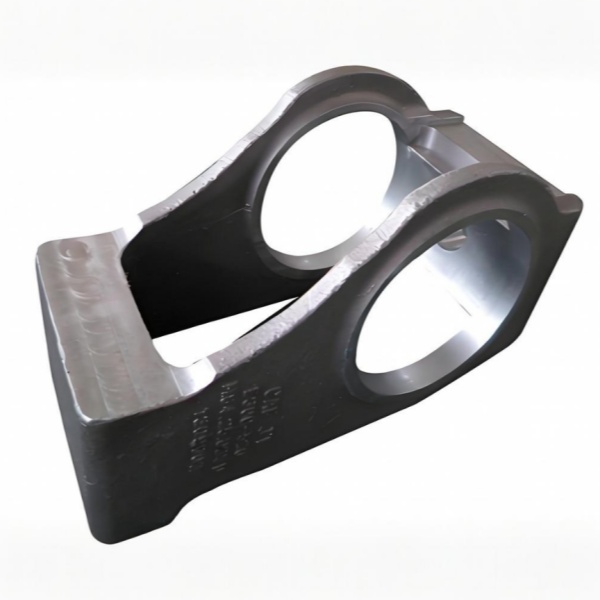
Characteristics of rail transit castings
High strength and high toughness: When rail transit is running. Castings need to withstand huge dynamic loads and impacts. For example, key components such as wheels and axles. So, high-strength alloy steel or high-quality cast iron must be used. It can ensure its safety and reliability under high speed and heavy load conditions. At the same time, it has a certain toughness to cope with vibration and stress concentration.
Excellent wear resistance and corrosion resistance: The wheels and tracks are subject to long-term friction. Vehicles are exposed to rain, snow, and corrosive gases outdoors. This requires castings to have excellent wear resistance and corrosion resistance. This is usually achieved through surface hardening treatment. Such as quenching, or the use of stainless steel, anti-corrosion coating, etc.
High precision and adaptability to complex shapes: To ensure accurate assembly and coordinated operation of all parts. Rail transit castings require extremely high dimensional accuracy. Usually 1-2 levels higher than ordinary castings. And, it needs to meet diverse functional requirements. It can produce castings with complex shapes such as rail connection blocks and fasteners.
Stable high and low temperature resistance: Rail transit equipment faces large temperature changes in different regions and seasons. From low temperatures in cold areas to high temperatures in hot environments. Casting materials need to maintain stable performance over a wide temperature range. Prevent structural damage or performance degradation due to thermal expansion and contraction or temperature stress.
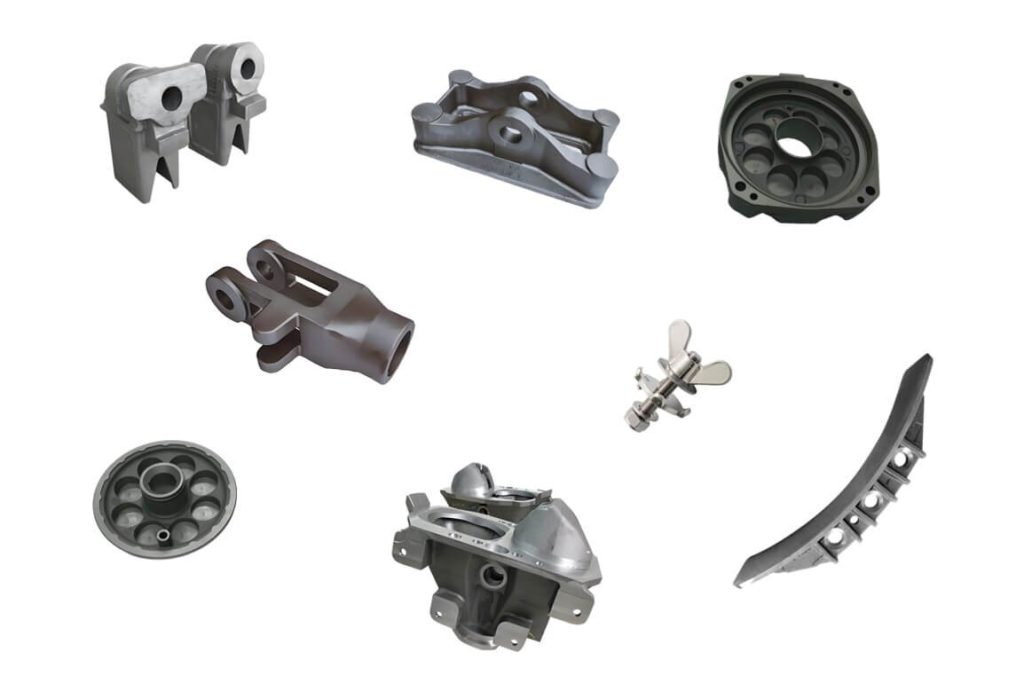
Common rail transit casting materials
High-strength cast steel, aluminum alloy, cast iron and other materials are mostly used. They meet the requirements of lightweight, high strength, wear resistance, corrosion resistance and other performance requirements. For example, aluminum alloy castings are often used in high-speed trains. They can reduce the weight of the car body and increase the running speed. Cast steel is widely used in parts that bear large loads such as bogies and couplers.
| Metal Type | Recommended Process | Advantages | Applications |
| Ductile iron | Sand casting | High strength, high toughness, excellent wear resistance and shock absorption. | Subway bogie frames, wheel hubs, high-speed rail brake discs. |
| Gray cast iron | Sand casting | Excellent casting fluidity. Good anti-friction and noise reduction. Low cutting cost. Low price. | Train gearbox housing, Motor housing, Brake disc base, Machine tool bed. |
| Cast steel | Sand casting | High strength and high rigidity. Excellent weldability and impact toughness. | High-speed rail couplers, locomotive frame supports, bridge supports. |
| Aluminum alloy | Die casting | Low density. Significantly lighter. Strong corrosion resistance. Good thermal conductivity. | High-speed train body structure, urban rail vehicle seat frame. |
| Stainless steel | Investment casting | Strong corrosion resistance. Smooth surface and easy to clean. High strength and wear resistance. Good oxidation resistance. | Subway vehicle body structure and panels. Railway freight cars. Train handrails, railings and other interior parts. |
| Copper alloy | Sand casting | Excellent anti-friction and wear resistance. Excellent electrical and thermal conductivity. Seawater corrosion resistance | Brush holders for rail transit motors. Bearing sleeves. |
JC Casting’s Casting Process
At JC Casting, we use a variety of casting processes to produce rail transit castings. These mainly include investment casting, sand casting and die casting. With many years of experience in manufacturing rail transit castings. We can provide process selection recommendations based on your part requirements. Ensure the delivery of high-quality products that meet stringent standards.
1. Casting process
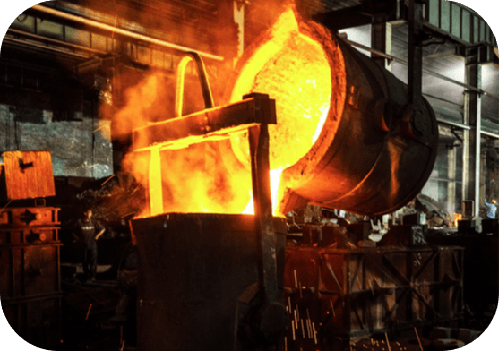
Sand casting
Use automated production lines to produce large and complex castings. For example, train bogie frames, large boxes, etc. During production, the sand mold shape is first optimized through computer design. Then the mold is made with special self-hardening sand materials. This process is highly flexible. It can meet the needs of single-piece customization. It is also suitable for small-batch production. Ensure that the shape and size of each casting meet strict standards.
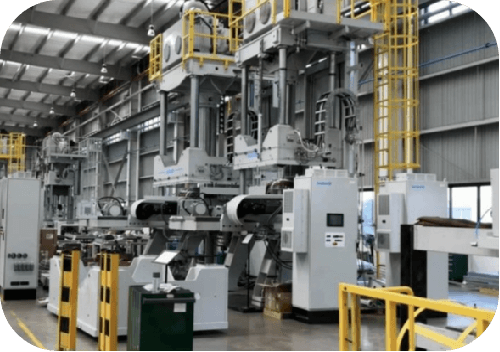
High-pressure die casting
Focus on the production of aluminum alloy castings. Car door frames, air conditioning compressor housings, etc. are manufactured through this process. Using large-scale die-casting equipment, the molten metal is injected into the mold at high pressure in a very short time. The castings produced are compact. There are few internal pores. Lightweight. High strength. High-pressure die casting has a fast production speed. It can meet the needs of large-scale orders.
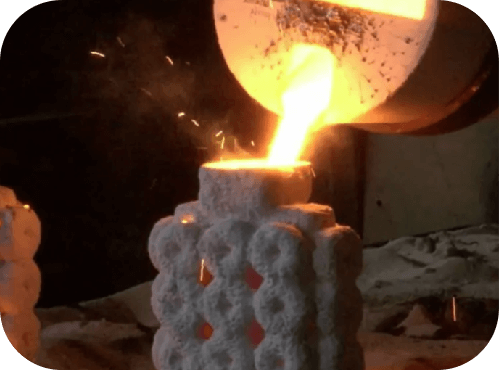
Investment Casting
For small precision parts such as brake valves and precision connectors. The investment casting process is used. First, a high-precision wax model is made. Then, a high-temperature resistant material is wrapped around the wax model to form a casting mold. After heating and removing the wax model, molten metal is injected to form the mold. This process can produce castings with smooth surfaces and complex structures. Even parts with complex pipes or small holes inside can be accurately cast.
2. Surface treatment process
1. Anti-corrosion coating treatment
To prevent rust and corrosion of castings used outdoors. JC Casting uses multiple layers of protective coating. First, a layer of anti-rust primer is sprayed on the surface of the casting. Then a wear-resistant protective layer is covered. Finally, an anti-ultraviolet protective coating is added. This treatment can make the castings less susceptible to damage in wind, rain, acid and alkali environments. And extend the service life.
2. Wear-resistant hardening treatment
For parts that often rub. Such as wheels and brake discs, JC Casting will perform surface hardening treatment. The surface of the casting is heated by special equipment. The surface becomes harder and more wear-resistant. It is like putting a layer of “armor” on the casting. It reduces wear in daily use and ensures safe operation.
3. Anti-rust galvanizing treatment
Some castings will be galvanized. A layer of zinc is covered on the surface. The zinc layer can effectively isolate air and moisture, preventing the casting from rusting. At the same time, it can also improve the appearance of the casting. This treatment is often used for rail connectors, fasteners and other parts.
4. Polishing
For some parts that require high-precision assembly. Such as valves, connectors, etc., fine polishing will be performed. Through mechanical grinding and chemical treatment. The surface of the casting becomes smooth and flat. Ensure that the parts fit tightly and reduce friction and noise during operation.
5. Painting treatment
To meet different appearance and protection needs, JC Casting also provides painting services. Choose paints of different colors and performances according to customer requirements. It can not only make the color of the casting beautiful and uniform. But also further enhance its anti-corrosion ability.
JC Casting: Your best casting partner for rail transit castings
JC Casting has many years of experience in manufacturing rail transit castings. With superb technology and mature processes. It continues to provide high-quality casting products to global customers. It is a leading domestic rail transit casting manufacturer.
During the production process, we implement strict quality control standards. Every link from raw material screening to finished product delivery has been carefully inspected. Whether facing complex climatic conditions or high-load operation scenarios. JC Casting’s rail transit castings can maintain stable performance. Ensure the safe and reliable operation of rail transit equipment.
Relying on advanced technologies such as investment casting, die casting, and sand casting. We can produce high-precision small parts. We also have the ability to manufacture large key castings. We provide one-stop services from design and development, mold making to product delivery. Our products are widely used in rail transit vehicle manufacturing, track laying engineering, signal system construction and other fields. Mainly including the following typical castings:
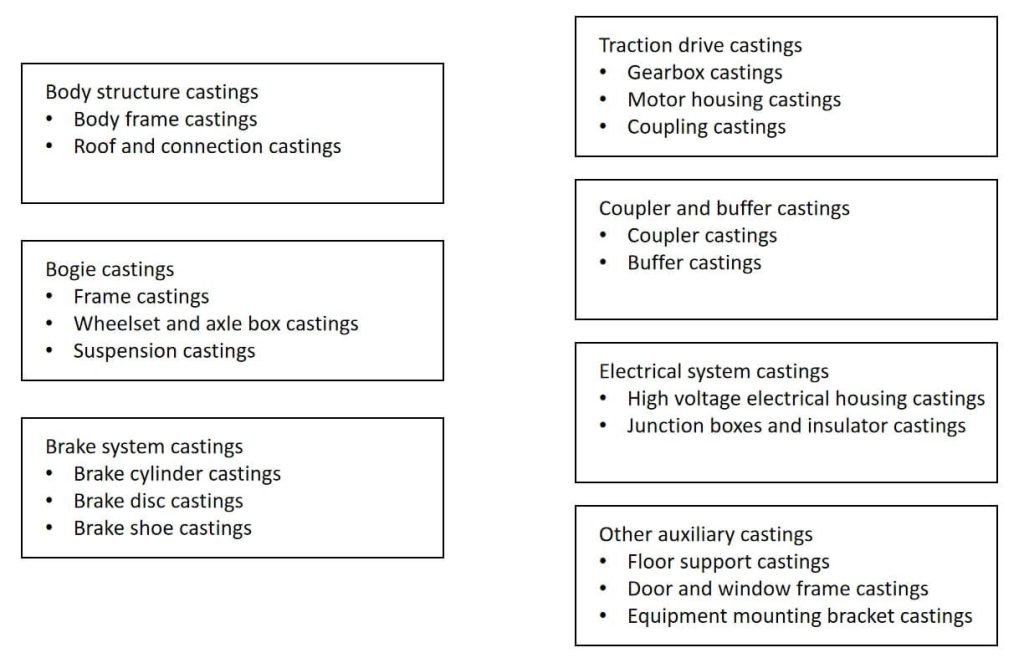
No matter what your project needs are. JC Casting’s professional team can provide you with customized casting solutions. If you have any needs, please feel free to contact us!
